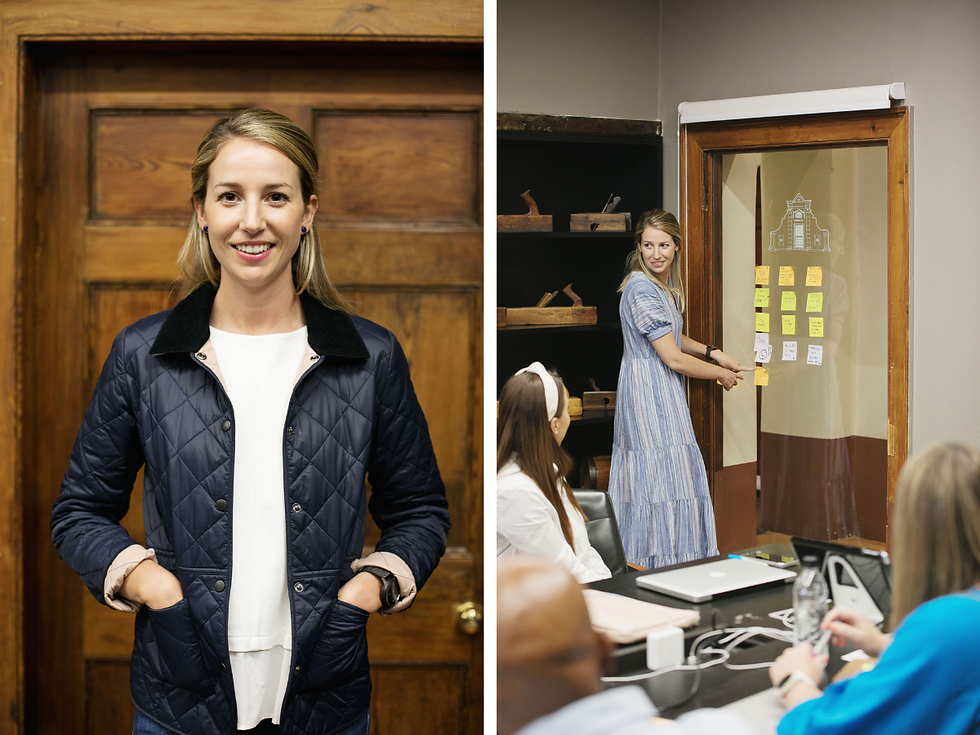Service Design Starts Here: With People, Practice, and Purpose
- Kaleidoscope

- Aug 2
- 3 min read
Designing systems and processes that go from Invisible to Indispensable
Aimee Fick doesn’t call herself a service designer. But spend five minutes with her in a working session, and it’s clear—she lives and breathes it.

At Kaleidoscope, service design isn’t a buzzword or a job title. It’s a way of thinking. A way of working. A way of deeply understanding people, process and potential. And one of the people quietly making it real every day is Aimee.
Aimee doesn’t wear the title of “service designer” loudly. But her work speaks volumes. Her fingerprints are found across platforms, journeys, processes and systems, each refined, restructured and made more usable by thoughtful iteration and constant, considered feedback. “I’ve always been drawn to how things actually work,” she explains. “Not just the shiny output, but what it takes to get there. Where people get stuck. Where flow breaks down. That’s where the work begins.”
As part of the Kaleidoscope team, Aimee plays a central role in designing services, systems and tools that make the complicated feel clear. Her approach is equal parts empathy and practicality. It blends structured mapping with a deep understanding of what clients, customers and teams are really trying to get done.
Service Design in Action “At Kaleidoscope, service design is everywhere,” Aimee says. “It shows up in how we run retrospectives, map touchpoints, and even write comms templates. For us, it’s not a department. It’s a way of working.”Aimee's focus is on building with, not for. Whether she’s guiding hospitals through tension cards or supporting developers on a product build, her strength lies in translating between people and process, vision and viability.

“One of the best things we do is hold the space for our clients to tell us what’s really happening,” she says. “We’re not trying to fix symptoms. We’re designing from the root causes.”
That insight-first mindset is central to Kaleidoscope’s approach. And it’s where Aimee thrives. She listens deeply, maps clearly, and iterates fast. From booking journeys in healthcare, to customer experience audits, to the tools teams use behind the scenes, she’s there, shaping how it works.
Making the Invisible Visible
“Service design gives us the discipline and tools to make the invisible visible,” Aimee reflects. “When you build in context, test with real feedback and evolve alongside users, people start to see the value. And they start to believe in it.”
Her ability to take a concept, pull it apart, and rebuild it in a way that works better for everyone is what makes her stand out.And it’s not just process diagrams and service flows. Aimee is deeply involved in live product development, taking the insight she gathers in workshops and feedback loops and translating it into features, fixes and functionality. Her work on Kaleidoscope’s smart theatre platform, Ultrasound, is a clear example of this thinking in motion.
“Between what the client is feeling, what the data is saying, and what the product team needs to build, I help make those connections real.” The Kaleidoscope Way
When asked what makes Kaleidoscope’s service design different, Aimee doesn’t hesitate. “We actually use the tools we talk about. We prototype in Airtable. We run our own retros. We’re constantly stress-testing the way we work.”

This inside-out view gives the team a real edge. It also allows Aimee to play to her strengths: empathy-led problem solving, structured thinking and building things people can actually use.
“I don’t want to design something beautiful that nobody touches,” she says. “I want to build something that flows better. That feels obvious. That just works.”
And if you ask her what her job is, she’ll tell you this: “I work in the space between people and systems. That’s where the magic happens.” Want to learn more about Kaleidoscope’s service design tools and approach?
Visit kaleidoscopesa.com



Recently I explored many mobile platforms and found a trustworthy service for players in India with fast deposits, timely withdrawals, and responsive support; midway through testing I registered via Betvibe online casino India which delivered a smooth signup, intuitive interface, transparent promotions, stable app performance, and consistently secure sessions for regular mobile play in India.
I first found official Betvisa website for BD while searching for a legal betting option that supports local payment systems. Many platforms don’t take bKash or Nagad, but this one does, which was a huge win. Registration took barely a minute, and the mobile version runs better than some apps I’ve tried. I’ve mainly used it for cricket betting, and so far, no weird bugs or payment issues. It just works — plain and simple, which is what most of us want in Bangladesh.